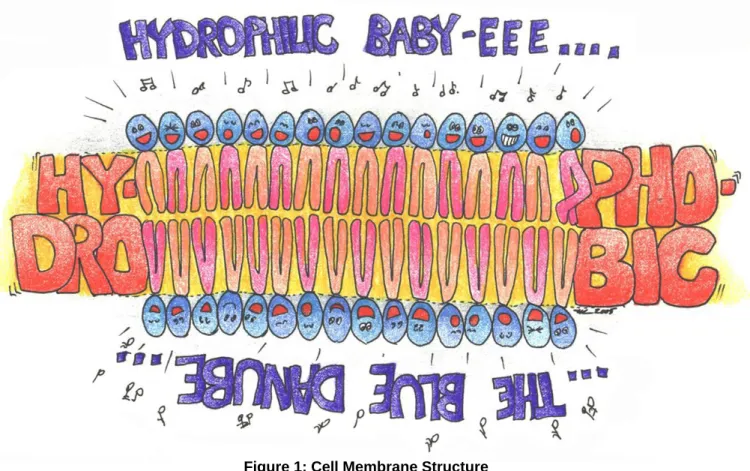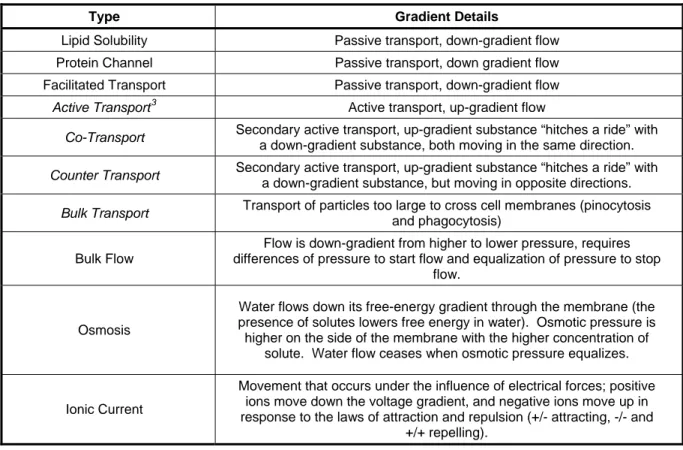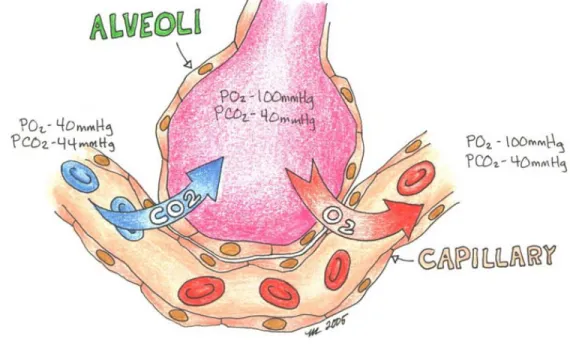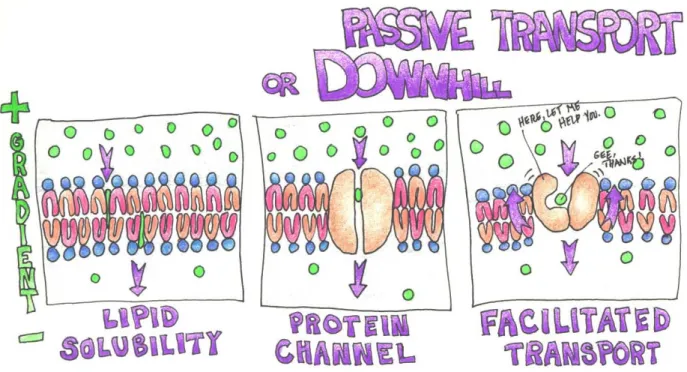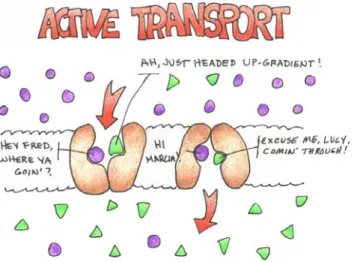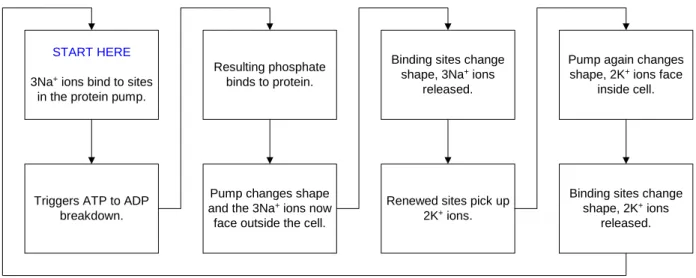Cell Membrane Structure (and How to Get Through One)
A cell’s membrane is a wall of sorts that defines the boundaries of a cell. The membrane provides protection and structure for the cell and acts as a barrier that helps control whether substances may come or go, and in what quantities. It consists primarily of two layers of lipids and throughout the membrane there are imbedded proteins serving specific functions. Phospholipids, the major structural component of a cell membrane, are comprised of a molecule of glycerol with two attached fatty acids and one phosphate group, which makes them a ‘non-nuetral’ lipid, or put another way, electronically polarized. They are aligned “tail to tail”, so the “heads” are either facing inward, or facing outward.1
Figure 1: Cell Membrane Structure
1
(in the case of epithelial cells, “outward” might mean laterally, toward other cells; toward the outside environment or lumen (empty space inside of organs); or toward the blood (capillaries); inward would mean towards the cytoplasm of the cell.).
Phospholipids are polarized at the head (hydrophilic – or strongly attracted to water) and non-polarized at the tail (hydrophobic – or repelled by water). When phospholipids are exposed to water (whose molecules are also polarized), they arrange themselves “head first” toward water molecules, so the “tails” stay high and dry2, as illustrated in Figure 1.
This polarizing action permits the lipids to form into single layers (micelles) or bi-layers (such as is the case with cell membranes), in a fluid but enclosed shape. In fact, the space in between the lipid “tails” is occuppied with cholesterol and other substances, contributing to fluidity and mobility. Imbedded proteins in the lipid layer may act as transporters (moving substances into and out of the cell), as receptors for hormones, and as catalyzers for chemical reactions, while still others play structural roles in holding cells together or assisting in the maintainenance of cellular shape.
Lipoproteins are concerned with the movement of lipids within the body, and eicosanoids play roles in the modification of hormonal response, promoting the inflammatory response, and the opening of airways (called prostaglandins) and in the allergic and inflammatory responses of the body (called leukotrenes).
Substance flow (movement) and transport (entering or exiting a cell) can occur in any number of ways, depending on the substance and the pathways. The basic means of flow and transport are summarized in Table 1.
2
The in-between space of a lipid bi-layer or within a micelle is not actually dry, as other fluid substances (a steroid known as cholesterol being the most prolific, and whose presence is required to form all other steroids) occupy these spaces.
Table 1: Substance Flow and Transport
Type Gradient Details
Lipid Solubility Passive transport, down-gradient flow Protein Channel Passive transport, down gradient flow Facilitated Transport Passive transport, down-gradient flow
Active Transport3 Active transport, up-gradient flow
Co-Transport Secondary active transport, up-gradient substance “hitches a ride” with
a down-gradient substance, both moving in the same direction.
Counter Transport Secondary active transport, up-gradient substance “hitches a ride” with
a down-gradient substance, but moving in opposite directions.
Bulk Transport Transport of particles too large to cross cell membranes (pinocytosis
and phagocytosis)
Bulk Flow
Flow is down-gradient from higher to lower pressure, requires differences of pressure to start flow and equalization of pressure to stop
flow.
Osmosis
Water flows down its free-energy gradient through the membrane (the presence of solutes lowers free energy in water). Osmotic pressure is higher on the side of the membrane with the higher concentration of
solute. Water flow ceases when osmotic pressure equalizes.
Ionic Current
Movement that occurs under the influence of electrical forces; positive ions move down the voltage gradient, and negative ions move up in response to the laws of attraction and repulsion (+/- attracting, -/- and
+/+ repelling).
Diffusion is a means of getting through a cell membrane wherein a substance moves across the membrane from its higher concentration to its lower concentration, so long as the molecules are small enough and a pathway is present. This is the case of Lipid Solubility, Protein Channels, and Facilitated Transport. Diffusion is the means of moving an oxygen molecule from an alveoli across membranes into the bloodstream as previously discussed in Unit 2. In the bloodstream, movement occurs via bulk flow, or the mass movement of fluid from the higher pressure gradient to the lower pressure gradient. In the case of blood, this is
3
accomplished by heart contractions. Once out in the capillary beds in various parts of the body, oxygen molecules and nutrients will diffuse out of the capillary and into the receiving tissue cells.
Figure 2: Lipid Solubility (One Method of Diffusion)4
Osmosis is another type of bulk flow involving the movement of water across a membrane that is permiable for the H2O molecule, but impermeable to larger molcules. In the case of osmosis, water actually crosses the membrane up-gradient toward the higher osmotic pressure (the side of the membrane with the higher concentration of solute). The water will carry all solutes across the membrane so long as the molecules are small enough to pass; and hose that are too large are held back.5 Osmotic flow is the means by which tissues swell and shrink.
4
Figure 2, from Unit 2, repeated here for illustrative purposes (honest).
5
Industrial applications use reverse-osmosis, a process that removes minerals and other impurities from water by forcing it through a semi-permeable membrane using induced pressure. The membrane is permiable for H2O
molecules, leaving most of the minerals and other substances behind. Triple-distilled water is passed through RO membranes three times and is fairly stripped of most content other than H2O.
In the case of transport into and out of cells, it is important to recognize that there must be more than a free energy gradient (a difference in concentration, pressure, or voltage) to permit transport – there has to be a pathway, or a means of permitting the movement through the membrane. Although the specific details of the pathways and precisely how transport occurs is still being researched and much remains to be understood, the following simplified explanations and diagrams provide an overview:
Figure 3: Passive Transport Mechanisms
In lipid solubility, the substances dissolve in the membrane, passively diffusing to the other side towards the lower gradient. Examples of this type of substance are steroid hormones, fat-soluble vitamins6, fatty acids, oxygen (Ah, here is Mr. O’Too again!) and carbon dioxide molecules.
6
An example would be vitamin D, which plays a very vital role in the regulation of Calcium levels. Others are A, E, and K.
Smaller solutes like sodium (Na+), potassium (K+) and calcium (Ca++) are able to pass through water-filled protein channels (openings created by clusters or folded proteins that extend from the outside to the inside of the membrane) to the lower gradient. Water moves in bulk through these channels and is regulated by osmotic pressure, and the solutes move with it.
In facilitated transport, larger substances, such as glucose, bind to a protein carrier that shifts or moves in such a way that the binding site is exposed to the outer surface of the membrane, then to the inner surface. The solute hitches a ride, so to speak, and travels down-gradient from the higher concentration to the lower.
Figure 4: Active Transport Mechanisms
Active transport requires energy release from the breakdown of ATP for the necessary boost to perform the work involved in moving substances up-gradient (like the extra exertion required to push something uphill versus allowing gravity to take it downhill). In all forms of transport involving specialized protein binding sites, the carrier sites are specific to the substances, and the rate of transfer is dependent upon the number of sites available.
In co-transport, the protien will have more than one binding site and transport takes place using the passive transport of one substance to complete the active transport of another. Once all the sites are occuppied (We’ll use Na+ and Glucose for this example), the pathway “rocks” and permits the entry of glucose up-gradient to its higher concentration while Na+ flows downhill to its lower concentration. Some amino acids are transported in this fashion.
Figure 5: Co-Transport and Counter Transport
In counter-transport, the process is very similar, but the binding sites vary and the substances will move in oposite directions (as in the case of sodium moving into a cell (downhill) and calcium moving out (uphill)).
Active transport ion “pumps” are protein structures in the cell membrane (and may be found in some endoplasmic reticulum) that function to maintain or regulate body processes by controlling the gradients of certain substances. These pumps function only with the breakdown of ATP (a high-energy phosphate is transferred into the protein and the pump becomes “phosphorylated.”). These highly complex structures are not yet fully understood.7 Below is a
7
And in my defense, if the scientists are still lost on this, then I have no business trying to explain it, but I am going to attempt the basics anyway.
basic process overview of what appears to be occuring in a Sodium-Potassium pump (which may require as much as 30% of the ATP needed for cellular metabolism):
START HERE
3Na+ ions bind to sites
in the protein pump.
Triggers ATP to ADP breakdown.
Resulting phosphate binds to protein.
Pump changes shape and the 3Na+ ions now
face outside the cell.
Binding sites change shape, 3Na+ ions
released.
Renewed sites pick up 2K+ ions.
Pump again changes shape, 2K+ ions face
inside cell.
Binding sites change shape, 2K+ ions
released.
Figure 6: Sodium-Potassium Pump Cycle
This particular pump functions to maintain osmotic stability (ensuring the cells do not fill with water and burst nor become void of water and collapse), bio-electricity (maintenance of the voltage gradient across the membrane for nerve function), secondary active transport (Na+ is required to transport glucose and amino acids in some cells – they cannot transport unless accompanied by Na+), and metabolism (the potassium-rich environment of the cell creates the perfect condition for efficient synthesis and the activation of some enzymes.8
Cell membranes have numerous other ion pumps that operate as an ATPase, functioning to maintain, control, or regulate: examples are the Ca++ ATPase (maintains intracellular calcium at very low levels) and the H+ - K+ ATPase, regulating acidity in the stomach and kidneys.
8
Finally, in bulk transport, large particles are moved into and out of cells through vacuoles, which are extensions of cytoplasm that engulf the particles. In small vacuoles, the process of breaking down the particles is known as pinocytosis. In larger vacuoles, particles such as foreign bodies, cell fragments, and microbes are broken down by enzymes released from attached lysosomes, in a process known as phagocytosis. Last, indigestible matter and waste leave the cell through the membrane in reverse (the waste is engulfed and removed, a process known as exocytosis).
Bibliography
Kapit, Macey, Meisami. The Physiology Coloring Book. San Francisco: Benjamin/Cummings Science Publishing, 2000.
Lippincott Williams & Wilkins. Anatomy and Physiology. Second Edition. New York: Lippincott Williams & Wilkins, 2002.
Waugh, Anne. Ross and Wilson: Anatomy and Physiology in Health and Illness. Spain: Elsevier Health, 2004.
